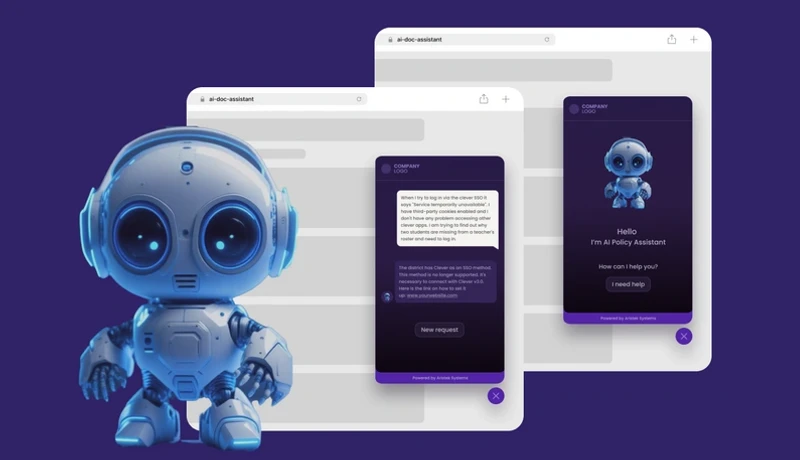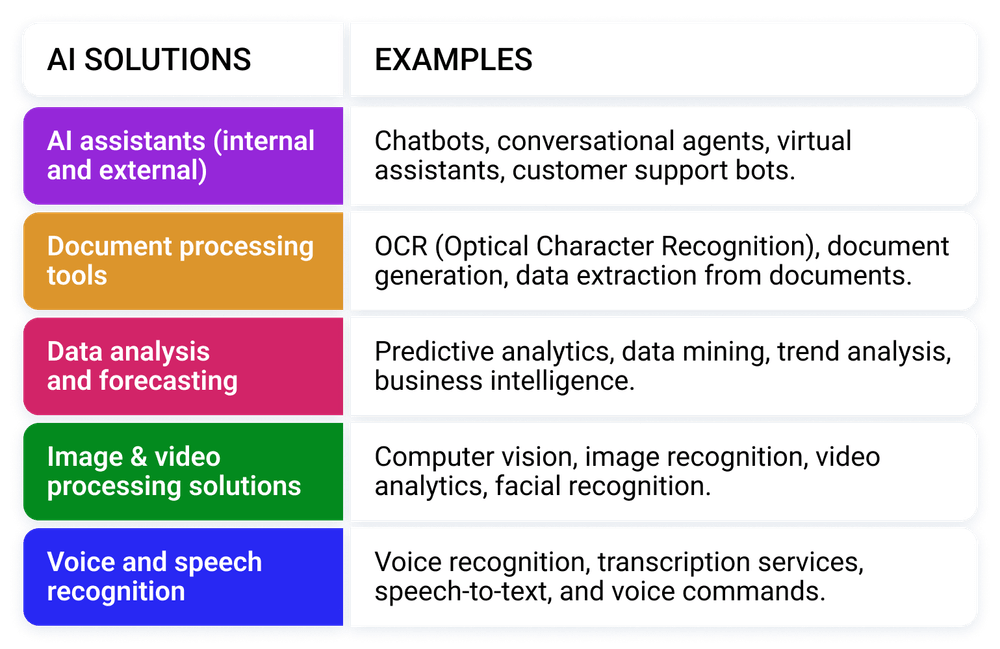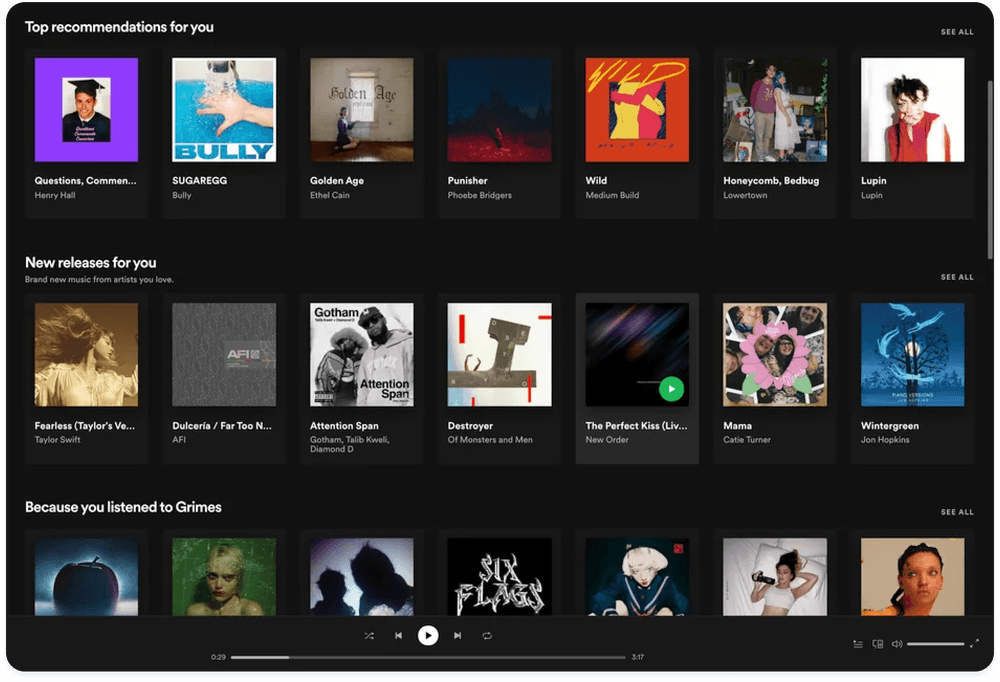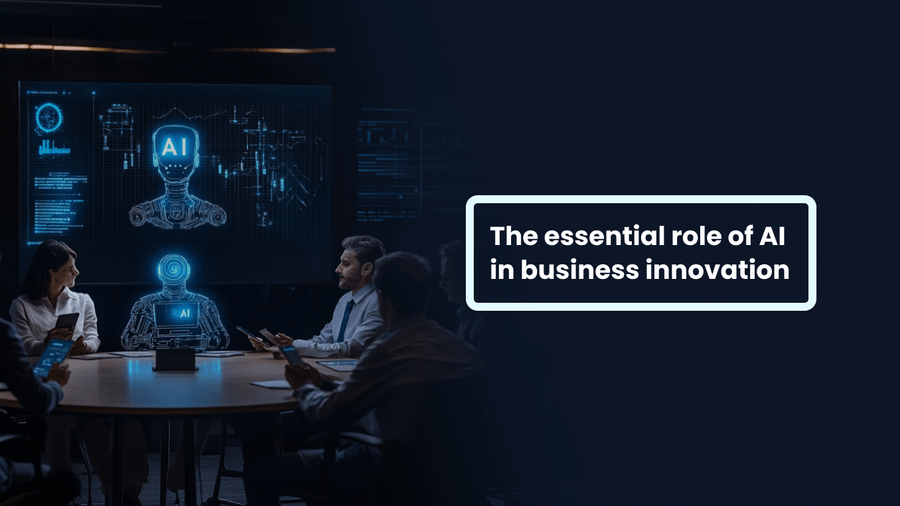While 65% of respondents report that their organizations are regularly using AI, according to the McKinsey’s 2024 AI survey, others are still waiting for the technology to advance and for AI expertise to become more widely available. However, waiting too long may be a missed opportunity… or a costly mistake.
In this article, you will discover how modern businesses use AI in their operations. But before that, let’s find out what AI solutions exist.
Types of AI solutions
AI comes in different flavors, and all of them can find its use in your business.
AI assistants
An AI assistant is software that uses AI to simplify access to information and automation across your business — targeting routine and complicated workflows. These assistants can be internal, helping employees streamline tasks, or external, enhancing customer interactions. Examples include chatbots, conversational agents, virtual assistants, and customer support bots.
But what does that look like in practice? Internally, AI assistants can fast-track employee onboarding, provide instant access to company policies, or navigate your entire knowledge base with just a query. Externally, they work around the clock, fielding customer inquiries, handling FAQs, and automating repetitive tasks — cutting down the need for human involvement.
Do you hire for customer support?
One of our clients replaced traditional hiring with an AI chatbot and achieved the following results: 24/7 instant assistance, lower costs, and happier customers.

Document processing tools
Does your company deal with mountains of paperwork, contracts, invoices, or any kind of documentation? Document processing tools can make this job easier. These tools capture, transform, and process data from documents (for example, email, text files, PDFs, or even scanned documents). With the help of AI technologies like computer vision, OCR, and Natural Language Processing, they can extract and analyze data, sort it, and send it where it needs to go.
These solutions can be used across various industries and business verticals. In education, they simplify student admissions by processing records in a snap. In retail, they help automate tasks like managing invoices. And in the logistics, they handle order forms and shipping docs, speeding up operations.
Data analysis and forecasting software
Today, success in business hinges on timely insights — there’s hardly anyone who would argue that. AI has become a powerful ally, not just in extracting data but also in analyzing it and predicting future trends.
AI-driven data solutions can help you extract value from your data and make decisions that make an impact:
- Predictive analytics software allows you to foresee outcomes based on historical patterns;
- Data mining tools can help you uncover hidden insights within large datasets;
- Trend analysis solutions will help you identify market changes before they happen;
- Business intelligence solutions can help you transform raw data into actionable strategies.
Planning to implement data analysis or predictive analytics software to your business?
Learn how much it could cost you.
Image & video processing solutions
One of the most important aspects of AI is its ability to interpret and process visual inputs, such as videos and images. This includes powerful solutions like computer vision, image recognition, video analytics, and facial recognition.
These technologies find applications in various fields. For instance, in healthcare, medical imaging analysis helps diagnose conditions more accurately. In agriculture, crop monitoring and analysis enable farmers to optimize yields. Manufacturing benefits from quality control systems that ensure product standards, while in real estate, virtual property tours allow potential buyers to explore homes from anywhere.
Voice and speech recognition tools
Without AI, Alexa or Siri wouldn’t understand what you say to them. AI is the backbone of voice and speech recognition technology, enabling these tools to interpret and respond to our requests effectively.
These solutions improve customer support, ensure accessibility for disabled individuals, and streamline data entry and can also be applicable in various fields, including medical imaging, videophones, character recognition, and satellite imagery.

Now, let’s explore how AI is applied in real-world scenarios across various industries.
AI in education
Learning process personalization
Recognizing that students have diverse needs is an essential ingredient for effective teaching. The best part is that detecting and meeting each learner’s unique requirements, which would have taken considerable time and effort twenty years ago, can now be achieved quickly and easily.
AI platforms can track student data like interaction with materials, test results, and performance to understand their needs. Using this data, generative AI can create personalized learning paths and adjust them in real-time.
For example, if a student struggles with English, the AI can generate custom exercises in listening, speaking, reading, or writing, and give instant feedback. It can also offer content in different formats to match the student’s learning style.

Curriculum design
Why did the curriculum designer refuse to play cards? Because they were tired of dealing with all the “curricular” shuffles! Yes, the constant changes in the knowledge base and its relevance make curriculum creation a notoriously difficult task, and for many, this joke is not just a punchline but a reality they face every day.
AI excels not only at creating personalized lesson plans for individual students, it also facilitates curriculum creation processes.
By processing vast amounts of data on student progress, interests, competencies, and challenges, AI can guide curriculum designers in enhancing teaching programs on a larger scale. AI algorithms can identify patterns and trends, evaluate the effectiveness of various pedagogical approaches, and predict the outcomes of different educational strategies.
Administrative workflow optimization
A one-hour dive into administrative tasks can drain a faculty member’s energy for creative work, like designing student assignments. Fortunately, AI can automate many of these tasks, allowing educators to focus on teaching and inspiring students.
Educational institutions can leverage AI to automate various administrative tasks, such as processing student applications, managing enrollments, handling HR procedures, and more. By integrating AI into these processes, schools can cut costs, boost efficiency, and better respond to student needs.
For example, the UK’s Department for Education has adopted a system that autonomously processes digital correspondence, speeding up the response time to incoming emails. This solution, developed with Capgemini, uses robotic process automation enhanced by AI.
Discover how we developed an AI-powered content generator
for knowledge assessment, helping our client save 90% in quiz creation time, achieve a +4 point increase in NPS, and boost conversion rates by 27%!

AI for healthcare
Virtual nursing
The UK’s Health Foundation reports over 100 million urgent care requests each year within the NHS. Innovative solutions like AI-driven virtual nursing are meeting public demands for 24/7 care.
Virtual nurses streamline various tasks, such as appointment scheduling, medication management, chronic disease support, post-discharge care, and emergency alerts. These solutions can be equipped with AI-powered avatars, available around the clock, can interact with patients, answer questions, and provide empathic support between doctor visits.
A good example is an application called AskFirst, that has an avatar, Molly. The avatar provides emotional support and understanding, making patients feel heard and cared for during their treatment.

Accurate diagnostics and high-risk patient identification
In healthcare, incorrect or incomplete diagnoses can severely impact patient outcomes, sometimes resulting in death.
To tackle this critical challenge, many companies are leveraging machine learning to enhance the accuracy of medical diagnostics. By integrating machine learning with pattern recognition and automation, clinicians can significantly speed up the identification of high-risk patients.
ML systems can analyze protected health information (PHI) and categorize patients into risk groups based on their identified risk levels.
Readmission reduction
Under HRRP, hospitals face penalties if patients are readmitted within 30 days after treatment for certain conditions. The goal is to encourage better discharge planning, follow-up care, and patient management to reduce unnecessary readmissions. AI can be a valuable tool for preventing these penalties.
For example, predictive analytics can identify patients at high risk of readmission after treatment by analyzing EHR data. These tools highlight factors that increase the likelihood of readmission and help care providers make better clinical decisions. This could include scheduling more follow-up visits, improving discharge instructions, or adjusting medication to prevent readmissions.
Looking to bring AI into healthcare?
Let’s work together to turn complex healthcare challenges into smart AI solutions!
AI for retail
Inventory management
For companies that sell products, inventory management is like walking a tightrope – one miscalculation, and you’re in trouble. Smart inventory management can help you not only maintain balance and avoid costly slips, but increase profit – effective inventory management and data-driven in-store optimization can boost retailer sales by an average of 10%.
Predictive analytics can help retailers forecast inventory needs and stock levels by analyzing past purchase patterns. These insights into customer demand allow companies to plan and improve their supply chains more easily.
Hyper-targeted advertising
Imagine browsing the internet and seeing an ad for something you’ve been thinking about. Some might say gadgets read our minds, but it’s really AI at work! According to Deloitte, retailers using data-driven targeting can achieve up to a 5x increase in product sales.
Targeted marketing uses data analysis and AI to understand consumer preferences and behaviors. This helps businesses send personalized ads, leading to higher engagement, better conversion rates, and smarter use of advertising budgets.
AI-driven pricing strategies
Setting the right price attracts customers and encourages purchases. It can seriously boost sales and cash flow. And there’s no better tool for price optimization than AI.
AI-driven pricing strategies use predictive analytics to help retailers understand market trends and customer data for better pricing. By recognizing customer groups and shopping trends, companies can adjust their products, services, and prices to meet customer needs, leading to more sales. In short, AI is like rolling out the red carpet for customers, inviting them in and encouraging them to buy!

Curious how AI can predict what your customers want before they do?
Check out how we helped a retail giant boost conversions and cut costs with AI-driven behavior analysis and sales forecasting!

AI for manufacturing
AI is now one of the main drivers of digital transformation in manufacturing. It improves many labor- and data-intensive processes, such as quality control, demand forecasting, production optimization, and others.
Predictive maintenance
One area where AI shines is predictive maintenance. Traditionally, maintenance is scheduled at regular intervals, which can be inefficient. Unexpected equipment failures can disrupt operations and lead to significant revenue losses.
By using machine learning and IoT technologies, manufacturers can continuously monitor equipment conditions. Sensors collect data from machines and send it to an AI system that analyzes performance. This system can identify potential issues early on and predict when equipment is likely to fail, allowing for timely repairs and minimizing downtime.
Product development
Forward-thinking manufacturing companies are using neural networks and deep learning to make product development faster and easier. This method, called generative design, lets users input details like available resources and how long they want to produce a product.
The system then works its magic to create designs automatically. This not only cuts down production time but also helps companies build better products. It’s a win-win situation that blends creativity with efficiency!
Quality control
Another way AI is changing manufacturing is through quality control. By using computer vision and machine learning, companies can automate this process, making it quicker and more effective.
Manufacturers know what their final product should look like and often have lots of data to help train the AI. This makes quality control a great fit for machine learning, leading to fewer errors and more consistent quality.
While these applications of AI are common across many manufacturing areas, there are also specific use cases tailored to different sectors. For example:
- Fruits and vegetables quality evaluation. Computer vision helps assess the quality of produce, ensuring only the best fruits and veggies make it to market.
- Automotive manufacturing. AI tools verify that each component is correctly assembled, ensuring safety and performance in vehicles.
- Furniture production. Visual inspection technology checks finished furniture pieces for quality, making sure every item meets standards.
- Plastic product manufacturing. Autonomous systems sort recyclable materials efficiently, supporting sustainability efforts.

AI for finance
Fraud detection and prevention
As businesses move online and grow digitally, they face increased risks of fraud and cyber attacks. In 2023, the finance industry became the second biggest target for criminals. Alarmingly, these threats are becoming more sophisticated, exploiting vulnerabilities in enterprises and causing significant damage, even in organizations we consider entirely secure, like Meta and NASA.
AI systems help fight fraud by spotting patterns that show suspicious activities. They reduce false alarms and improve detection accuracy, helping to identify bad users and fraudulent transactions in real-time. Machine learning looks for unusual behaviors, enabling banks to act quickly.
Want to improve security in your financial organization? Adding a secure messaging app can be a good strategy. Check out our article, “Secure Messaging App for Financial Companies” to find out how a customized solution can keep your communications safe.
Credit scoring
Issuing loans always comes with risks for lenders. AI can reduce these risks by improving credit scoring.
Rather than relying only on traditional methods like credit history, income, and debts, AI-based credit scoring takes into account a wider range of data, including digital footprints. By using advanced algorithms to analyze this information, AI can predict a person’s future financial behavior, offering lenders deeper insights for better decision-making.
Algorithmic trading
Another AI use case in the financial industry is algorithmic trading. In this context, AI enables traders to execute transactions instantly, eliminating delays from human decision-making. By analyzing vast amounts of data, AI-driven algorithmic trading allows traders to:
- Quickly respond to market changes with effective strategies, especially in day trading.
- Capitalize on emerging opportunities.
- Refine trading strategies while minimizing biases and emotions, such as the fear of missing out (FOMO).
Using AI has its risks, but it also provides useful insights and support based on data. While AI can’t promise success in the market, it can be a helpful partner in handling the challenges of trading.
AI in entertainment
AI-generated content
Ever wondered how movie trailers seem to hit all the right notes? AI does some of the heavy lifting! By analyzing previous trailers and audience reactions, AI can predict which scenes will captivate viewers and piece together a trailer that maximizes hype.
Personalized user engagement
AI is getting personal. Streaming platforms use deep learning to monitor how long you stay glued to a show, what makes you stop, and even what gets you hooked again. This data helps tweak content, suggest the perfect binge-watch, and even drive the marketing behind the scenes. So next time you see a show recommended just for you, there’s a good chance AI had a hand in it.

AI in sports
Precision analysis in play
AI has become the referee we all trust – literally. It analyzes the exact millimeter of a photo finish or assesses ball trajectory in tennis, thus ensuring fairness and accuracy. With its real-time data crunching, AI eliminates human error and makes sure that every call on the field is as precise as possible.
Player performance and strategy
AI can also become the team’s secret coach. From tracking player fatigue to analyzing tactical decisions, AI provides insights that human coaches can only dream of. The tech processes player data, predicts the effectiveness of strategies, and even offers adjustments during the game. It’s like having a virtual assistant that knows exactly when to push for a goal or when to pull back.
Fan experience upgrades
AI is also changing the game for fans. Stadiums and sports apps use AI to personalize the fan experience: it recommends the best seats based on past preferences to deliver real-time stats or highlights tailored to each fan’s favorite players or teams.
Got inspired? Why wait!
So, you have some great ideas for using AI in your business. What comes next? If you’ve chosen your AI use case, the best time to start is now. Aristek is ready to share our knowledge and help you every step of the way. Book a free consultation with us today and let’s get started!




